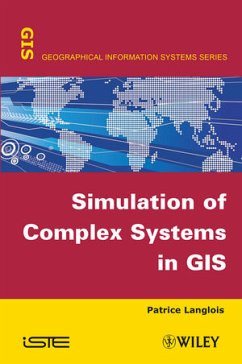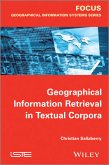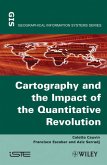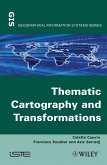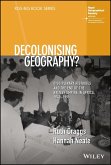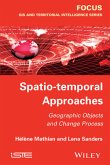Simulation of Complex Systems in GIS (eBook, ePUB)


Alle Infos zum eBook verschenken

Simulation of Complex Systems in GIS (eBook, ePUB)
- Format: ePub
- Merkliste
- Auf die Merkliste
- Bewerten Bewerten
- Teilen
- Produkt teilen
- Produkterinnerung
- Produkterinnerung

Hier können Sie sich einloggen

Bitte loggen Sie sich zunächst in Ihr Kundenkonto ein oder registrieren Sie sich bei bücher.de, um das eBook-Abo tolino select nutzen zu können.
This book provides a comprehensive view of the field of geographical modeling by dividing the topic into three parts. The first part of the work establishes the foundations of geographical modeling through the use of more general concepts, including: structure, organization, system, geometries, topologies, metrics, material, and object. Finally, introduction of the concept of time leads to the theories of process and spatial interaction, which are fundamental in geography. The second part of the book tackles the use of computer tools for dynamic model building, which are the geographic…mehr
- Geräte: eReader
- mit Kopierschutz
- eBook Hilfe
- Größe: 5.7MB
![Geographical Information Retrieval in Textual Corpora (eBook, ePUB) Geographical Information Retrieval in Textual Corpora (eBook, ePUB)]() Christian SallaberryGeographical Information Retrieval in Textual Corpora (eBook, ePUB)139,99 €
Christian SallaberryGeographical Information Retrieval in Textual Corpora (eBook, ePUB)139,99 €![Fractal Geography (eBook, ePUB) Fractal Geography (eBook, ePUB)]() André DauphineFractal Geography (eBook, ePUB)139,99 €
André DauphineFractal Geography (eBook, ePUB)139,99 €![Participatory Mapping (eBook, ePUB) Participatory Mapping (eBook, ePUB)]() Jean-Christophe PlantinParticipatory Mapping (eBook, ePUB)139,99 €
Jean-Christophe PlantinParticipatory Mapping (eBook, ePUB)139,99 €![Thematic Cartography, Volume 2, Cartography and the Impact of the Quantitative Revolution (eBook, ePUB) Thematic Cartography, Volume 2, Cartography and the Impact of the Quantitative Revolution (eBook, ePUB)]() Colette CauvinThematic Cartography, Volume 2, Cartography and the Impact of the Quantitative Revolution (eBook, ePUB)167,99 €
Colette CauvinThematic Cartography, Volume 2, Cartography and the Impact of the Quantitative Revolution (eBook, ePUB)167,99 €![Thematic Cartography, Volume 1, Thematic Cartography and Transformations (eBook, ePUB) Thematic Cartography, Volume 1, Thematic Cartography and Transformations (eBook, ePUB)]() Colette CauvinThematic Cartography, Volume 1, Thematic Cartography and Transformations (eBook, ePUB)167,99 €
Colette CauvinThematic Cartography, Volume 1, Thematic Cartography and Transformations (eBook, ePUB)167,99 €![Decolonising Geography? Disciplinary Histories and the End of the British Empire in Africa, 1948-1998 (eBook, ePUB) Decolonising Geography? Disciplinary Histories and the End of the British Empire in Africa, 1948-1998 (eBook, ePUB)]() Ruth CraggsDecolonising Geography? Disciplinary Histories and the End of the British Empire in Africa, 1948-1998 (eBook, ePUB)25,99 €
Ruth CraggsDecolonising Geography? Disciplinary Histories and the End of the British Empire in Africa, 1948-1998 (eBook, ePUB)25,99 €![Spatio-temporal Approaches (eBook, ePUB) Spatio-temporal Approaches (eBook, ePUB)]() Hélène MathianSpatio-temporal Approaches (eBook, ePUB)139,99 €
Hélène MathianSpatio-temporal Approaches (eBook, ePUB)139,99 €-
-
-
Dieser Download kann aus rechtlichen Gründen nur mit Rechnungsadresse in A, B, BG, CY, CZ, D, DK, EW, E, FIN, F, GR, HR, H, IRL, I, LT, L, LR, M, NL, PL, P, R, S, SLO, SK ausgeliefert werden.
- Produktdetails
- Verlag: Wiley
- Seitenzahl: 328
- Erscheinungstermin: 4. Februar 2013
- Englisch
- ISBN-13: 9781118600993
- Artikelnr.: 38254056
- Verlag: Wiley
- Seitenzahl: 328
- Erscheinungstermin: 4. Februar 2013
- Englisch
- ISBN-13: 9781118600993
- Artikelnr.: 38254056
- Herstellerkennzeichnung Die Herstellerinformationen sind derzeit nicht verfügbar.
PART 1. THE STRUCTURE OF THE GEOGRAPHIC SPACE 1
Part 1. Introduction 3
Chapter 1. Structure and System Concepts 5
1.1. The notion of structure 5
1.2. The systemic paradigm 10
1.3. The notion of organization 13
Chapter 2. Space and Geometry 29
2.1. Different theories of space 29
2.2. Geometry and its data structures 43
2.3. "Neat" geometry and "fuzzy" geometry 60
Chapter 3. Topological Structures: How Objects are Organized in Spatial
Systems 67
3.1. Topology 67
3.2. Metrics and topologies 68
3.3. Calculated topology, structural topology 71
3.4. Hierarchization 78
Chapter 4. Matter and Geographical Objects 79
4.1. Geographic matter 79
4.2. The notion of observation 82
4.3. The geographic object: Definitions and principles 84
Chapter 5. Time and Dynamics 97
5.1. Time 97
5.2. Temporalities 100
5.3. Events, processes 105
5.4. Decomposition of a complex process 115
5.5. An epistemic choice: reciprocal dependency between the complexity
levels of a phenomenon 117
Chapter 6. Spatial Interaction 121
6.1. Presentation of the concept 121
6.2. Definition of macroscopic interaction 125
6.3. The four elementary (inter)actions 127
6.4. Microscopic interaction like a multigraph 128
6.5. Composition of successive interactions 130
6.6. The configurations and the trajectories of a simulation are categories
131
6.7. Intermediary level matrix representation 133
6.8. Examples of interactions 134
6.9. First definition of the notion of spatial system 138
Part 1. Conclusion: Stages of the Ontogenesis 141
PART 2. MODELING THROUGH CELLULAR AUTOMATA 145
Chapter 7. Concept and Formalization of a CA 147
7.1. Cellular automata paradigm 148
7.2. Notion of finite-state automata 150
7.3. Mealy and Moore automata 151
7.4. A simple example of CA: the game of life 152
7.5. Different decompositions of the functions of a cell 153
7.6. Threshold automaton, window automaton 155
7.7. Micro level and Stochastic automaton 156
7.8. Macro level and deterministic automaton 156
7.9. General definition of a geographic cellular automaton 157
7.10. Different scheduling regimes of the internal tasks of the system 160
7.11. Ports, channels, encapsulation 162
7.12. Interaction 164
7.13. Space associated with a geographic cellular automaton 168
7.14. Topology and neighborhood operator of a GCA 168
7.15. The notion of cellular layer 168
7.16. Hierarchized GCA models 169
Chapter 8. Examples of Geographic Cellular Automaton Models 171
8.1. SpaCelle, multi-layer cellular automaton 172
8.2. Example: the evolution model of the Rouen agglomeration 181
8.3. RuiCells 189
8.4. GeoCells 207
Part 2. Conclusion 235
PART 3. A GENERAL MODEL OF GEOGRAPHIC AGENT SYSTEMS 237
Part 3. Introduction 239
Chapter 9. Theoretical Approach of an Integrated Simulation Platform 241
9.1. For an integrated platform of simulation 241
9.2. General specifications 242
Chapter 10. A Formal Ontology of Geographic Agent Systems 245
10.1. The conceptual framework 245
10.2. The notion of a geographic agent system 247
10.3. A generalization of the notion of process 249
10.4. The notion of a geographic agent 250
10.5. The formalization of the notion of organization 258
10.6. The formalization of behavior 268
10.7. Formalization of a general AOC model 279
10.8. The Schelling model example 280
Part 3. Conclusion 283
General Conclusion 285
Acronyms 291
Bibliography 293
Index 299
PART 1. THE STRUCTURE OF THE GEOGRAPHIC SPACE 1
Part 1. Introduction 3
Chapter 1. Structure and System Concepts 5
1.1. The notion of structure 5
1.2. The systemic paradigm 10
1.3. The notion of organization 13
Chapter 2. Space and Geometry 29
2.1. Different theories of space 29
2.2. Geometry and its data structures 43
2.3. "Neat" geometry and "fuzzy" geometry 60
Chapter 3. Topological Structures: How Objects are Organized in Spatial
Systems 67
3.1. Topology 67
3.2. Metrics and topologies 68
3.3. Calculated topology, structural topology 71
3.4. Hierarchization 78
Chapter 4. Matter and Geographical Objects 79
4.1. Geographic matter 79
4.2. The notion of observation 82
4.3. The geographic object: Definitions and principles 84
Chapter 5. Time and Dynamics 97
5.1. Time 97
5.2. Temporalities 100
5.3. Events, processes 105
5.4. Decomposition of a complex process 115
5.5. An epistemic choice: reciprocal dependency between the complexity
levels of a phenomenon 117
Chapter 6. Spatial Interaction 121
6.1. Presentation of the concept 121
6.2. Definition of macroscopic interaction 125
6.3. The four elementary (inter)actions 127
6.4. Microscopic interaction like a multigraph 128
6.5. Composition of successive interactions 130
6.6. The configurations and the trajectories of a simulation are categories
131
6.7. Intermediary level matrix representation 133
6.8. Examples of interactions 134
6.9. First definition of the notion of spatial system 138
Part 1. Conclusion: Stages of the Ontogenesis 141
PART 2. MODELING THROUGH CELLULAR AUTOMATA 145
Chapter 7. Concept and Formalization of a CA 147
7.1. Cellular automata paradigm 148
7.2. Notion of finite-state automata 150
7.3. Mealy and Moore automata 151
7.4. A simple example of CA: the game of life 152
7.5. Different decompositions of the functions of a cell 153
7.6. Threshold automaton, window automaton 155
7.7. Micro level and Stochastic automaton 156
7.8. Macro level and deterministic automaton 156
7.9. General definition of a geographic cellular automaton 157
7.10. Different scheduling regimes of the internal tasks of the system 160
7.11. Ports, channels, encapsulation 162
7.12. Interaction 164
7.13. Space associated with a geographic cellular automaton 168
7.14. Topology and neighborhood operator of a GCA 168
7.15. The notion of cellular layer 168
7.16. Hierarchized GCA models 169
Chapter 8. Examples of Geographic Cellular Automaton Models 171
8.1. SpaCelle, multi-layer cellular automaton 172
8.2. Example: the evolution model of the Rouen agglomeration 181
8.3. RuiCells 189
8.4. GeoCells 207
Part 2. Conclusion 235
PART 3. A GENERAL MODEL OF GEOGRAPHIC AGENT SYSTEMS 237
Part 3. Introduction 239
Chapter 9. Theoretical Approach of an Integrated Simulation Platform 241
9.1. For an integrated platform of simulation 241
9.2. General specifications 242
Chapter 10. A Formal Ontology of Geographic Agent Systems 245
10.1. The conceptual framework 245
10.2. The notion of a geographic agent system 247
10.3. A generalization of the notion of process 249
10.4. The notion of a geographic agent 250
10.5. The formalization of the notion of organization 258
10.6. The formalization of behavior 268
10.7. Formalization of a general AOC model 279
10.8. The Schelling model example 280
Part 3. Conclusion 283
General Conclusion 285
Acronyms 291
Bibliography 293
Index 299
